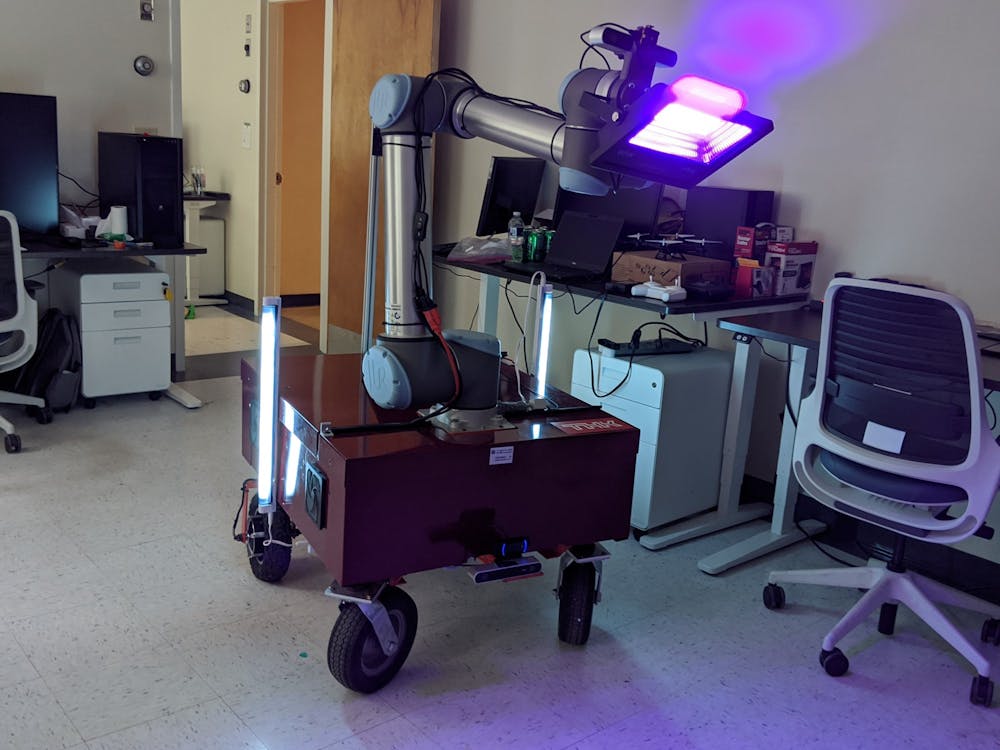As the country begins to reopen amid COVID-19, one potential way to limit the spread of the virus is by decontaminating surfaces in public spaces. Dr. Tomonari Furukawa — mechanical and aerospace engineering professor — and his team have developed a robot that aims to kill the novel coronavirus using ultraviolet light. This robot was designed to decontaminate whole rooms while under remote control.
Prior to COVID-19, Furukawa and his team designed a robot to enter an international robotics competition called the Mohamed Bin Zayed International Robotics Challenge held in late February. The goal of the competition was to develop a robot that could respond to emergency situations, including locating and putting out a fire.
When COVID-19 emerged as a threat in the U.S. shortly after the competition ended, Furukawa moved quickly to modify the robot for use during the COVID-19 pandemic.
“If people are suffering, the role of the University is really to improve the quality of life of people,” Furukawa said. “I didn’t care whether I was sponsored or anything — I just self-funded the project and we started to work at once.”
Within a month and a half, Furukawa’s team adapted their disaster-response robot into a decontamination robot. Since Furukawa moved from Virginia Tech to the University last August, work on the robot has become a collaborative effort between the institutions. Yet, since the pandemic began, work on the robot has mostly taken place in Blacksburg, Va. due to travel restrictions and living situations. Both team members are currently employed by the University in some capacity.
Furukawa’s team has chosen to work in a home garage to make progress on the robot since access to the workplace at Virginia Tech has been restricted due to the COVID-19 pandemic.
Dean Conte, a mechanical engineering graduate student from Virginia Tech on Furukawa’s team, explained how the robot’s hardware has been adapted by replacing firefighting machinery with ultraviolet lamps for decontamination.
“The benefit from the [robotics] competition is we had something that worked reliably and consistently, so it was easy to adapt the end effectors,” Conte said. “[We] put the UV light on the end, and that wasn’t a terribly difficult task … it was simple wiring.”
Previous research has demonstrated that ultraviolet light is effective at destroying coronaviruses related to SARS-Cov-2 — the virus that causes COVID-19 — and there is emerging evidence that SARS-Cov-2 is also susceptible to ultraviolet light. Ultraviolet light disrupts the genetic material of many microorganisms, rendering them unable to function properly, which results in the death of the microorganism.
Furukawa’s robot differs from other robots in that its ultraviolet lamps can sweep all surfaces of a room, or spot-decontaminate high-touch surfaces, rather than solely decontaminating the air. The robot is equipped with a camera and software that allow it to build a 3D map of a room and precisely record which surfaces have already been decontaminated.
The robot typically operates in a room without a human present, which is necessary considering ultraviolet light can be dangerous to human health. But the robot does not have full autonomy — an operator oversees the robot’s functions remotely and can intervene if necessary.
Spencer Leamy, Furukawa’s former student and software developer, explained that ease of operating the robot has been a high priority in developing the robot for use in healthcare settings, where time may be limited.
“Teaching somebody how to operate [the robot] is like teaching somebody how to play a video game — it’s very simple. We literally use Xbox controllers [to move the robot],” Leamy said. “Basically, we’ve built everything to support the operator … to make [remote operation] as easy as possible.”
The goal is to have an average person trained to control the robot in under an hour. One operator could theoretically operate several robots at once — decontaminating multiple rooms in a matter of minutes.
The team has also given the robot its own Wi-Fi network to avoid interfering with hospital networks.
In addition to healthcare settings, Furukawa foresees the robot being used for decontaminating other public spaces, like grocery stores, to prevent the spread of COVID-19 and other infectious diseases.
“We are talking about [applications of the robot to] normal life,” Furukawa said. “Similarly to vacuum cleaners … we might need to have a Roomba for decontamination next anywhere high touch is occurring, such as supermarkets and grocery stores.”
No matter where the robot is deployed, Furukawa mentioned collaboration is key to assessing the robot’s effectiveness in serving the public.
Furukawa is actively looking for collaborators within the U.Va. Health System and at other facilities to test and use the robot for SARS-Cov-2 decontamination. The Health System has expressed interest in the decontamination robot but testing has not yet been implemented.
“We are looking for collaborators, always,” Furukawa said. “COVID-19 is not even a U.S. problem — this is an international problem and we need to collaborate and overcome this crisis together.”







